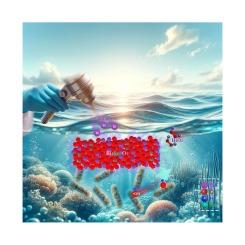h2o2辅助金属负载Bi2Sn2O7高效光催化海洋细菌去除
IF 5.9
3区 工程技术
Q1 CHEMISTRY, MULTIDISCIPLINARY
Journal of Industrial and Engineering Chemistry
Pub Date : 2025-05-10
DOI:10.1016/j.jiec.2025.05.005
引用次数: 0
摘要
压载水危险增长及其潜在的广泛扩散问题对海上运输经济的可持续发展构成了重大挑战。本文提出了一种简化且可持续的方法来合成金属双掺杂Bi2Sn2O7,并在H2O2的辅助下构建了一个类fenton体系,用于光催化海洋细菌的失活。金属Bi的引入有利于整体灭菌效果的提高,特别是3BBSO (Bi/Bi2Sn2O7)在海洋细菌灭活中表现出最佳的选择性,H2O2的分解得到改善。金属Bi与附加的H2O2结合有助于光生电荷的分离和•OH自由基的产生,从而提高天然海水中的杀菌效率。此外,表征结果表明,金属铋是自由电子富集和•OH吸附中心的关键活性位点,增加了光吸收范围,促进了光催化细菌的灭活。DFT模拟表明,金属Bi提供了H2O2丰度的最佳位置,利用聚集的电子产生更多的•OH自由基。这一可持续框架通过降低海洋微生物浓度,为压载水的处理提供了宝贵的见解。本文章由计算机程序翻译,如有差异,请以英文原文为准。

H2O2-assisted metallic Bi-loaded Bi2Sn2O7 for efficient photocatalytic marine bacteria removal
The notorious issue of hazardous growth in ballast water and its potential for widespread diffusion pose significant challenges to the sustainable development of maritime transportation economies. Here, a simplified and sustainable method is presented for synthesizing metallic Bi-doped Bi2Sn2O7, assisted by H2O2 to construct a Fenton-like system for the photocatalytic inactivation of marine bacteria. The introduction of metallic Bi is beneficial to the overall sterilization improvement, notably, the 3BBSO (Bi/Bi2Sn2O7) exhibits optimal selectivity in marine bacteria inactivation, with improved decomposition of H2O2. The combination of metallic Bi and additional H2O2 contributes to the separation of photo-generated charges and the production of •OH radicals, thereby enhancing sterilization efficiency in natural seawater. Furthermore, characterization results demonstrate that the metallic Bi act as a pivotal active sites for the enrichment of free electrons and adsorption centers for •OH, increasing the light absorption range and promoting photocatalytic bacterial inactivation. DFT simulations suggest that metallic Bi provides an optimal position for H2O2 abundance, utilizing aggregated electrons to generate more •OH radicals. This sustainable framework offers valuable insights into the treatment of ballast water by deactivating the concentration of marine microorganisms.
求助全文
通过发布文献求助,成功后即可免费获取论文全文。
去求助
来源期刊
CiteScore
10.40
自引率
6.60%
发文量
639
审稿时长
29 days
期刊介绍:
Journal of Industrial and Engineering Chemistry is published monthly in English by the Korean Society of Industrial and Engineering Chemistry. JIEC brings together multidisciplinary interests in one journal and is to disseminate information on all aspects of research and development in industrial and engineering chemistry. Contributions in the form of research articles, short communications, notes and reviews are considered for publication. The editors welcome original contributions that have not been and are not to be published elsewhere. Instruction to authors and a manuscript submissions form are printed at the end of each issue. Bulk reprints of individual articles can be ordered. This publication is partially supported by Korea Research Foundation and the Korean Federation of Science and Technology Societies.

 求助内容:
求助内容: 应助结果提醒方式:
应助结果提醒方式:


